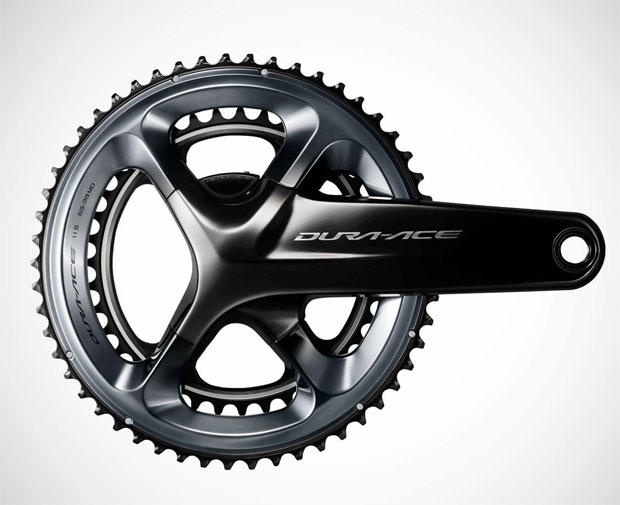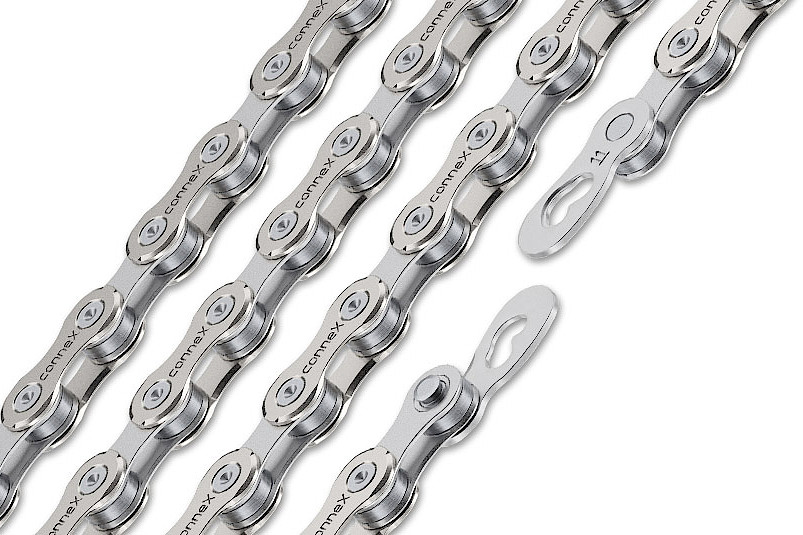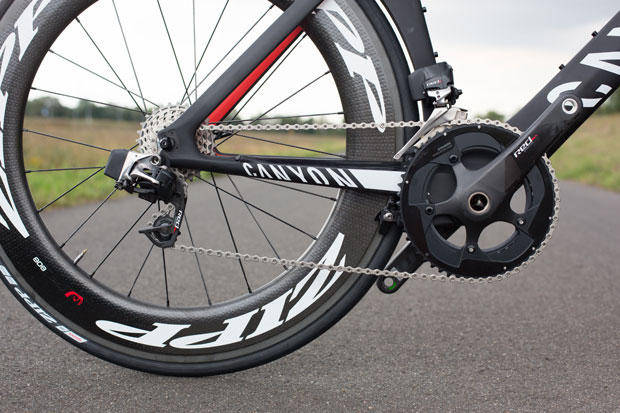Shimano Di2 versus SRAM eTap
Mass customization is coming to bikes. How soon? I don't know. I would say soon on bikes where the complete bike price is above $3,500.
Getting the frame you want with the kit (and wheels, etc.) you want is possible on Diamondback’s configurator for its Andean and Serios tri bikes and Trek’s Project One buying experience has offered this for years (though not at price points like those Diamondback is hitting). Wrench Science gives you this, but only for Argon18 and Orbea. When will Cervelo, Felt and other companies follow suit?
I don't know, but it's time now to think about groupkits, shift systems, wheels, saddles as products you can choose when buying a bike, rather than as aftermarket upgrades.
Your most obvious choice now is SRAM versus Shimano, but those who’re particular have already made their decisions about electronic versus mechanical. About 500 of you answered a flash poll recently and 42 percent of you said Di2 was for you on your next tri bike. SRAM’s eTAP polled at 35 percent, so, pretty close. SRAM’s’s 1x was preferred by 8 percent of you, so, SRAM and Shimano are in a dead heat among Slowtwitchers with Shimano a slight winner among electronic shift systems.

You’ll note that those numbers gobble up a lot of you, and only 15 percent of you chose “other.” What could “other” be? Mechanical, mostly. Yes there is Campagnolo’s electronic and FSA looks to have done a nice job on its electronic group. Some of you are holding out for XShifter. Still, more than 3 out of 4 Slowtwitchers are going to choose either eTAP or Di2 if they have a choice, and they will have a choice.
Which is the better group? It depends on what you value. After having spent many hours using both here’s my current opinion although, as Ferris Buehler inimitably said, “Life moves pretty fast.” I might have different opinions in 6 months.

May I give a shout out our Reader Forum users, whose opinions and experiences I asked about this? If you don’t ask you don’t know. I was surprised (I shouldn’t have been) at the ingeniousness of some – how affordably they electrify the shifting on their bikes; how inexpensively the make a really nice tri bike through buying a mechanically-shifted bike and hopping it up.
Shift quality
You might think this metric rises above all others. Maybe it does. If so, let me save you reading anything further below. Shimano wins. From the moment Shimano first introduced Di2 its shifting has been spot-on. Its shifting is faster, more precise, more predictable than SRAM’s eTAP or Campagnolo’s electronic shifting for that matter.
What amazed me the first time I used Di2 is the auto-trim of the front derailleur. Really, the front derailleur shifting is the major selling point of electronic shifting (to me). I have never, in hundreds of hours of riding, tens of thousands of shifts, ever derailed a chain on a bike outfitted with Di2. It is simply the best. I don’t think it’s gotten any better since it was first introduced because the shifting was perfect when it was first introduced. The major difference in shifting then-to-now is that it happens over 11 gears in the back instead of only 10.

This isn’t to say that eTAP is now disqualified from consideration. SRAM’s shift system is better than Di2 in certain ways as will be described below. And it shifts great! I have no complaints about eTAP as a shift system. It’s like comparing Veronica Lake to Lana Turner. There is nothing to criticize about Veronica Lake. But… Lana Turner!
Wired versus Wireless
I never had a case of a wire coming undone inside one of my Di2 frames. So, that’s a concern, but it’s not a problem I have had. Still, if it happened that would be a cluster-mess. I also haven’t found a case of signals dropping with (wireless) eTap. So, there are the theoretical problems with each system but I have had nothing but practical success with both.
SRAM’s eTap is very easy to install. It’s not entirely wireless, just, the only wires to worry bout are those extending from the Blip Box (the “brains” of the system) out to the shifters. Not having wires go through the frame or from the battery to the derailleurs is a blessing. Score this for SRAM.
Convenience and ergonomics of shifters
Here is another area where SRAM’s group excels (though Shimano is edging closer). SRAM’s eTAP gives you two options: a bar-end button (Clic) or a button placed anywhere you want (Blip). What’s nice about these is that you don’t mess up the ergonomics of the aerobar extensions. S-bend extensions are dead. What still lives are either standard race- or ski- or J-bends or Wrist Relief bends. In each case the terminus of the extension angles up. When you add extra length to these extensions, then they’re really sticking up. No good. And that’s the problem we’ve had with Di2: the shifters add unwanted extra length to the extensions. The image third from the bottom is a Slowtwitcher’s eTap build (Dirt Fighter on our Reader Forum) using Clics. Just below that is his same bike showing a nice clean routing to the Blip Box, and the image furthest below, propped up against Slowman’s desk where he’s writing this, is Slowman’s use of 4 Blips on his eTap build.

Certainly Shimano lessened the problem with its slimmed-down 2-button shifters such as the Ultegra R671 Di2 TT, and better yet with the Dura-Ace Di2 9071 single-button shifter. But it still wasn’t as good as the shifter options SRAM offered.
What I have not seen, have not tried, are Shimano’s SW-R9160 "bar end shift switch.” Quite Clic-like. Conceptually this would close the gap between eTAP and Di2 in this area but, as noted, I haven’t gotten my grubby little hands on it. If this shifter works well this is a major deal for Shimano. You’ll see the aero shifter options in the image just below.
Intuitive shifting
Shimano overestimated us. Do you know where today's 1-button shifting comes from? Our inability to remember which button does what on a 2-button system. If you ask me, as I’m sitting here, I’ll tell you. But when my heart is pounding and I’m tired my body goes into a need-to-know mode and it routinely decides that I don’t need to know which button is upshift and which is downshift. No matter that the buttons are different sizes. Hundreds of hours of use hasn’t changed things.
The most intuitive bar-end shift system was and is Campagnolo’s. It simply made a shift lever that mimicked mechanical. But, electronic? What I can master – barely – are a pair of buttons, one on the left, one on the right. That’s what SRAM did. One button places us in a bigger year; the other in a smaller gear. What about the front derailleur? You push both buttons at the same time. There is no up or down, just, whatever chain ring the chain sits on, pushing both bar-end shifter buttons on an eTAP system simultaneously means the front derailleur places the chain on the other ring.

So far, with what is currently out for purchase, tie goes to SRAM on intuitive shifting. But something else is sitting out there, waiting to be exploited, that appeals to the dumbest version of me. It’s sequential shifting. I push a button, the gear gets bigger. I push a different button and the gear gets smaller. The system (not me) decides what the derailleurs need to do. Shimano has had this for its off-road shift systems. It works like 1x (where there is only 1 shifter because there is only one chain ring in front). Shimano’s electronic brain automatically decides what the next gear up or down is and it makes the shifts both in the front and the back. it’s called Synchronized Shift (or Synchro Shift).
To my knowledge SRAM is not offering sequential shifting… yet. However, with Shimano's new SW-R9160 (that new Shimano bar-end shifter I referenced above) you apparently can choose sequential shifting as an option. Further, Shimano has made it easy to update your firmware and change your shift system’s setting via its E-Tube Project.
Not that you all should use sequential shifting, because I haven’t used it and I don’t know that I’ll like it. But the fact that it’s available is a tick on Shimano’s side of the ledger.
The next step for these companies is to make their shift systems automatic, that is, you determine a desired cadence range, you perhaps change that range based on power (as the power goes up the cadence goes up?); you change it based on the pitch of the road (as the pitch goes up the cadence goes down?); and so forth. This is easy to do, but neither Shimano nor SRAM has done it. ProShift has done it and it works with either SRAM or Shimano, but that’s a topic for another time.

I think Shimano’s new 9150 Dura Ace Di2 with its SW-R9160 bar-end shift switches sounds like the state of the art. Conceptually. I haven’t tried it. You get sequential shifting and a very low-profile shifter, very dumbed-down for dummies like me, together with the best-shifting system going. There are some issues, however. Do you want shifting at the pursuit position? If so, you get that by using Shimano’s electronic combo shifter-brake lever. But what if your frame or aerobar comes with a lever? Or with hydraulic brakes? Or disc brakes?
Pursuit bar shifting is one conundrum with Shimano. If you don’t want, or can’t use, the pursuit bar shifter/brake levers, but you still want shifting at the pursuits, SRAM makes this easy. Shimano not quite so. Shimano makes two remote shift modules, and I’ve included its Climber Switch in the image of Shimano shifters above. At least one Slowtwitcher has these on his tri bike, at the pursuit position. I haven’t tried this. SRAM’s Blips are a simpler solution. Shimano’s Sprinter Switch can’t be used with bar-end electronic shifters. These can only be ported into Road Controls. So the wisdom goes. However one Slowtwitcher reports that he’s got Sprinter Switches plugged into his 5-port junction and they work fine as pursuit shifters. I’ll investigate this.
There are still things that eTAP will do better (original assembly, disassembly for shipping, and no wires through the frame) but in terms of the raw function of the system when you’re aboard and riding, my sense tells me Dura Ace 9150 will be the best, with the caveats expressed above. But this is at the Dura Ace level and, mind, I haven’t tried 9150 yet. Once you move below this eTAP starts to look pretty darned good. It’s simple, and it’s not priced much above Ultegra. Still, Ultegra 6870 looks good for the most price sensitive applications, especially if you’re not picky how and where you find and buy the sub-assemblies.

Battery placement, battery life and ease of charging
SRAM eTap is easy: the batteries are part of the derailleurs. Each derailleur has its own battery (and they are interchangeable). Shimano has one battery that runs the whole system. Which is better? I think more people tend to like the individual batteries. That’s the motif FSA chose when designing its system. But we’re again pitting two really good systems against each other, like choosing between Hedy Lamarr over Vivien Leigh (or Cary Grant versus Randolph Scott for those so-inclined). I have had no trouble either system. Both work perfectly in my experience.
Ease of assembly
Neither is that hard to assemble. SRAM is the easiest, because there are no shift wires leading from the front of the bike to the back and there is no need to find a place for the battery and run a wire from the battery to the rear junction.
SRAM's Blip Box causes some folks consternation. But double sided tape (it comes with tape or get yourself a roll of 3M double sided tape) works pretty well with this. Dirt Fighter’s bike shows you what a clean eTap assembly looks like.
Compatibility with other components
A lot of you are going to choose other chains and cassettes. Part of the reason is money. Part is performance. PremierBike is selling super-optimized Wippermann chains. Ceramic Speed sells its UFO chain. Some prefer KMC chains. Both these companies are going to warn against using others’ chains. I haven’t found a compatibility problem so far between any of these chains and either electronic shift system.
On-board metrics
Shimano has a technology called D-Fly. It’s a wireless sensor that sends information about your electronic shift system to your compatible head unit, like a Garmin, but Shimano makes its own head units as well. What information? Battery life, and what gear you’re in (so you don’t have to look back and see). This doesn’t make your shifting wireless, it just send that data wirelessly to your head unit. The D-Fly part number is EW-WU111, it’s about to premier, it replaces the EW-WU101, these units are affordable ($50 to $80). This is a feature that SRAM doesn’t have. Is this a feature that you need? I don’t know. When I’m riding I’m looking at other metrics, like power, or cadence, or elapsed time. Is it worth my while to switch the display to see what gear I’m in? Versus simply looking down to see what gear I’m in?
LATE ADD: Since posting this article (3 hours ago) I've been further educated on the topic of metrics, specifically that SRAM eTap's gear profile and battery life are now viewable on your Garmin (your 520 and 1000 at a minimum).

Price
SRAM makes it easy to buy just the shift kit and it’s in the $1,500 to $1,600 neighborhood. This is just what you need to electrify your shifting: 4 Blips (or Clics, or a couple of each); Blip Box, derailleurs, batteries and so forth (as in the image highest above). These are the indispensable parts of a shift system. Of course SRAM and Shimano will want you to buy their brakes, cranks, chain, but riders are getting particular about these. SRAM eTAP looks pretty good once you step down from the new – as yet unreleased – Dura Ace 9150. Here’s what your eTap electronic shift kit consists of:
– Four Blip satellite shifters (or Clics for bar-end instead of Blips, or perhaps 2 Blips and 2 Blip Grips)
– BlipBox control module
– Front and rear derailleurs (plus batteries)
– BlipBox handlebar mount
– Charger
– USB stick for firmware updates
Ultegra 6870 looks good as well if you are on more of a budget (that’s the image second from the top). If you root around, buying on eBay and from overseas, either as a group or piece by piece, you could piece it together for as little around $1000 (for just bar-end shifting) and as much as $1400 or $1500 (if you want Shimano's pursuit levers that shift). With SRAM it’s pretty easy, but with Ultegra you have more decisions to make, specifically, whether you want shifters in just one place or two; where do you want to put the battery and the junction boxes, and whether you want Shimano’s D-Fly system:
– Front and rear derailleurs
– SW R671 bar-end shifters
– Battery (internal or external) + mounts
– E-Tube 3- or 5-port box + rear junction box
– Battery charger (internal or external)
– Down tube wire (700-1000mm)
– RD wire (450-600mm)
– FD wire (350-500mm)
– Battery wire (600mm)
– ST 6871 brake levers/pursuit shifters (optional): You must decide whether you need shifters at the pursuit position. If you do, you add about $240. Just, even if you want them, is your frame compatible with these? Does your new frame have its own pursuit levers? Is your new frame going to have disc brakes? Hydraulic brakes?
– D-Fly unit (optional) + 150mm wire
As to Dura Ace 9150, with those nifty SW-R9160 bar end shift switches, and sequential shifting, I don’t know what it will cost. The street price, from overseas, on a mail order electronic 9070 group kit (the current Dura Ace Di2 full kit) is $2,300 versus a projected price of $3,900 for 9150 from the same retailer. However, when I look at projected prices for 9150 FD, RD, the bar-end shifters, and assuming wires, junction boxes, batteries are ubiquitous between Shimano’s group kits it seems to me just an electronic shift kit shouldn’t cost more than $2000 or so, or $2,500 if you include electronic-shift brake levers.
Finally, what about electronic 1x? Yes, people are doing that right now. But the kits are not optimized for this. I haven’t seen an electronic RD with a clutch, nor have I seen one that accepts more than a WiFli-range in the cassette (up to 32 teeth?). I would imagine we’ll tackle the question of how to do electronic 1x in a separate article.






